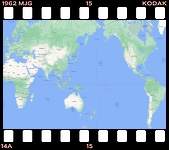On 25th August I was up early, to get the train to Auschwitz.
I was already well aware that a train to Auschwitz was the last journey for countless hundreds of thousands of innocent people. My trip there was something of a pilgrimage. It took 90 minutes to get to Oswiecim, which is the Polish name for the village. When I got off the train it didn’t look particularly remarkable. I left my backpack at the left luggage in the station, and headed for the original “Auschwitz 1” concentration camp.

It was quite chilling to walk in under the infamous and cruelly ironic Arbeit Macht Frei sign. Inside I was immediately struck by how neat, tidy, and carefully laid out everything was. The buildings were functional but not unattractive. Nobody who didn’t know what had happened here would immediately see anything sinister.
In the museum, I watched a film in English that was made by the liberating Red Army, which explained what they found – clearly they wanted to make sure the evidence was preserved on film immediately.
I wandered round “Auschwitz 1”. Even though I knew more or less what had happened here, it was still very sobering to stand where a portion of history’s greatest crime was committed.
But the truly shocking thing was to see how carefully and professionally this factory of death had been constructed. It wasn’t the work of incompetent madmen, but of educated architects, engineers, and craftsmen, who clearly took great pride in their work.
It was literally industrial scale slaughter of human beings – an efficient mechanised production line of murder. Entire families of healthy people went in one end – ash and smoke came out of the other end.
It seemed somehow wrong, even sacrilegious, that I should be allowed to now walk the length of that barbaric production line: in through the dark door of the gas chamber, along its horrific length, round to the incinerators at the other end…
It took 45 minutes to walk to the much larger “Auschwitz 2” camp at Birkenau, just outside the main village on the west side. It was 45 minutes during which my brain tried to process what I had just seen. I came no closer to processing it than I did after seeing Tuol Sleng and the Killing Fields of Cambodia.
Then, at Auschwitz 2, it was what I’d already seen… but on steroids. It made the factory of death at “Auschwitz 1” look like a quaint cottage industry.
The camp was huge, and the railway lines led through the gate across the vast compound and then stopped. Either side of the end of the railway line, installed with barbaric symmetry, were the 2 main gas chambers. The Nazis had tried to destroy them when the Red Army was approaching, as though they really thought that might hide what they had been doing. But, incredibly, they evidently had little idea that what they were doing was wrong.
Each gas chamber – now just a large open rectangular pit with the roof lying on the bottom – had stairs leading down at one end, and the dynamited ruins of the incinerators and chimneys at the other end. It was really hard to get my head around the incomprehensible amount of fear, heartbreak, and suffering that had taken place exactly where I stood. And it all happened for no logical reason whatsoever.
I then wandered through some of the wooden prison huts that have been preserved – they were like animal stables. There were a few places where sketches had been made of daily life in the camps by those who, for whatever reason, the Nazis had decided to keep alive as slave labour.
Towards mid afternoon, I decided I couldn’t really take any more, and walked slowly back towards the station. I managed to get a train to Katowice, an hour to the north, and there I was able to buy myself a ticket for the overnight train to Prague.

I wandered a little way from the station to get some food and drink. The can I bought split open when I pulled the ring, and I complained loudly enough that they gave me another one for free. I couldn’t work out what kind of defect could have caused the can to do that.

Back at the station I found the Prague train and located my seat. I was a little surprised to find that it wasn’t a sleeper. This was because every train I’ve been on since leaving South America has been a sleeper train, and I had virtually forgotten that non-sleeper trains exist. So it hadn’t even occurred to me, when I bought the ticket, to ask if the train was a sleeper – I had just assumed it would be!
Fortunately I was sitting opposite a talkative American girl called Heidi, and I chatted to her so much that I forgot there was no bunk to climb into.


No matter how much one reads about Auschwitz and the mind boggling atrocity it was built to conduct, being there and feeling that atmosphere of dread must have been humbling.
I cannot imagine the scene in Auschwitz. When I went to Berlin in 2018, my mom asked if we were going there. I told her, if she wanted to, we would go, but it was a 5 hour train ride one way from Berlin. I had read stories about people who got to the gate or were still on the train who could not get off of the train once they arrived. In Berlin, no matter where you go, you can’t escape scenes or reminders of WWII. At first, it seems odd, but then, I appreciated the message; ‘it’s not glory; it’s a reminder this should never be allowed to happen again.’ The reminders are purposeful, yet just the same, heartbreaking.